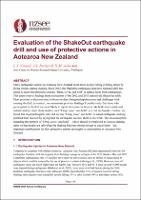| dc.description.abstract | Many earthquake injuries in Aotearoa New Zealand result from people falling or being struck by flying objects during shaking. Since 2012, the ShakeOut earthquake (and now tsunami) drill has aimed to teach the protective actions “Drop, cover, and hold” to reduce harm from earthquakes. This paper reports findings from evaluations of the 2012 and 2015 nationwide ShakeOut drills. Most previous evaluations tend to focus on describing participation rates and challenges with running the drill; in contrast, we summarize previous findings from this study that those who participated in the drill are more likely to report the correct actions to take both when inside and outside and are more likely to have used “Drop, cover, and hold” in a real earthquake. Further, we found that most participants who did not use “Drop, cover, and hold” in actual earthquake shaking justified their inaction by saying that the earthquake was too short or too weak. This misconception regarding the purpose of “Drop, cover, and hold” – which should be employed as soon as shaking starts so that people are safe when the shaking becomes strong enough to cause harm – has important ramifications for how protective actions are taught to communities in Aotearoa New Zealand. | |

